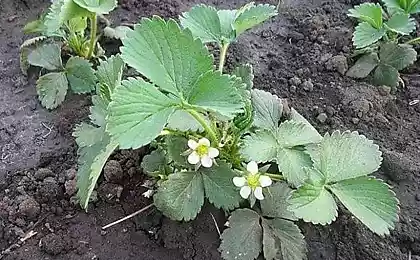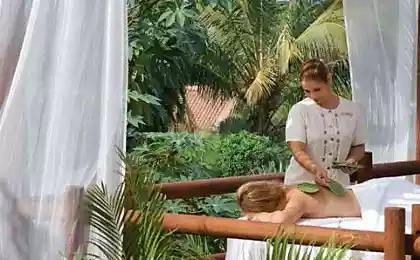481
Spiders masquerading as bird droppings
Thick spider web pattern in the centre of the trapping network is confusing predatory wasps, which take the web with spider for a spot of bird droppings.
Many animals use camouflage to avoid being noticed by predators. Usually the potential victim is trying to become one with the countryside: someone pretending to be a twig, some leaves, some with a piece of tree bark. The spider Cyclosa ginnaga comes extravagant all – he, as found by researchers from the National University of Chung-Hsing in Taiwan, trying to look like, so more like a stain from bird droppings.
C. ginnaga refers to the spiders of the Orb-web spiders are the ones that hang network, like a coil with many radii, and themselves or sit in the center, or hiding somewhere near, under leaf. C. ginnaga the lovchej networks makes web spot, and a silver-brown body of a spider on a background of whitish spots along the spider really looks like a smeared bird droppings.

The researchers claim that it can help the spiders to avoid attacks by predatory wasps. Zoologists have analyzed the spectral reflectance of the body of a spider, its spider pattern and present stains from bird droppings – that is, in other words, they are using optical methods to check whether the spider plus web in the eyes of the OS will be similar to the bird's spot. Indeed, it turned out that the spider on spider the pattern loses its features, like blurring on that spot, and the whole composition becomes generally indistinguishable from bird droppings.
The researchers tried to artificially darken the body of a spider, its spider pattern, or both at once. Wasps began increasingly to attack the spider, if the pattern around him became darker than usual. Obviously, it is a whitish background, on which sits the spider, and knocks the predators confused into accepting the spider droppings of a bird. All the work of zoologists published in Scientific Reports, briefly about it can be read in LiveScience.
The authors emphasize that C. ginnaga likely not the only spider that uses such a strange method of masking. A similar pattern doing the spiders and the spiders balamory-bokachoda. Although neither one nor the other don't build circular webs and are waiting for their prey sitting on the ground or on a tree, they nevertheless surround themselves spider spot, which again is easily mistaken for a stain bird droppings.
Incidentally, similar spider pattern, not only assembled in the center and stretched along the radius of the trapping network, use some other types of Orb-web spiders. Such a zigzag pattern is called stabilimentum, and bird droppings won't get messed up. Zoologists still argue, why do spiders need it – whether for camouflage, or to strengthen the web, or to attract a mate, or for something else. Two years ago researchers from the University of Incheon have noticed that a zigzag pattern on the web many of Orb-web spiders reflect ultraviolet light, and in this regard it has been suggested that stabilimentum helps the spiders to catch insects-pollinators, whose eyes are tuned to this range.
Source: nkj.ru
Many animals use camouflage to avoid being noticed by predators. Usually the potential victim is trying to become one with the countryside: someone pretending to be a twig, some leaves, some with a piece of tree bark. The spider Cyclosa ginnaga comes extravagant all – he, as found by researchers from the National University of Chung-Hsing in Taiwan, trying to look like, so more like a stain from bird droppings.
C. ginnaga refers to the spiders of the Orb-web spiders are the ones that hang network, like a coil with many radii, and themselves or sit in the center, or hiding somewhere near, under leaf. C. ginnaga the lovchej networks makes web spot, and a silver-brown body of a spider on a background of whitish spots along the spider really looks like a smeared bird droppings.

The researchers claim that it can help the spiders to avoid attacks by predatory wasps. Zoologists have analyzed the spectral reflectance of the body of a spider, its spider pattern and present stains from bird droppings – that is, in other words, they are using optical methods to check whether the spider plus web in the eyes of the OS will be similar to the bird's spot. Indeed, it turned out that the spider on spider the pattern loses its features, like blurring on that spot, and the whole composition becomes generally indistinguishable from bird droppings.
The researchers tried to artificially darken the body of a spider, its spider pattern, or both at once. Wasps began increasingly to attack the spider, if the pattern around him became darker than usual. Obviously, it is a whitish background, on which sits the spider, and knocks the predators confused into accepting the spider droppings of a bird. All the work of zoologists published in Scientific Reports, briefly about it can be read in LiveScience.
The authors emphasize that C. ginnaga likely not the only spider that uses such a strange method of masking. A similar pattern doing the spiders and the spiders balamory-bokachoda. Although neither one nor the other don't build circular webs and are waiting for their prey sitting on the ground or on a tree, they nevertheless surround themselves spider spot, which again is easily mistaken for a stain bird droppings.
Incidentally, similar spider pattern, not only assembled in the center and stretched along the radius of the trapping network, use some other types of Orb-web spiders. Such a zigzag pattern is called stabilimentum, and bird droppings won't get messed up. Zoologists still argue, why do spiders need it – whether for camouflage, or to strengthen the web, or to attract a mate, or for something else. Two years ago researchers from the University of Incheon have noticed that a zigzag pattern on the web many of Orb-web spiders reflect ultraviolet light, and in this regard it has been suggested that stabilimentum helps the spiders to catch insects-pollinators, whose eyes are tuned to this range.
Source: nkj.ru
New drug for leukemia improves survival rates to 90%
Original Unverpackt – a supermarket without packaging in Germany























